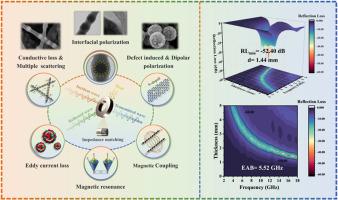项链结构FeCoNi@N-doped多孔碳纳米纤维强磁耦合高性能微波吸收
IF 9.8
1区 材料科学
Q1 MATERIALS SCIENCE, COMPOSITES
引用次数: 0
摘要
一维(1D)碳基磁性纤维具有合理的多组分调节和精细的微观结构设计,是高性能电磁波(EMW)吸收的有希望的候选者。然而,传统的一维吸收体经常受到密集聚集和随机取向的磁性纳米颗粒嵌入碳基体的影响,这严重限制了磁耦合,从而影响了磁损耗能力。在本研究中,通过水热合成、同轴静电纺丝和可控碳化的协同作用,成功制备了嵌入FeCoNi纳米颗粒(FeCoNi@NPCNFs)的一维项链状氮掺杂多孔碳纳米纤维。通过精确调节磁性纳米颗粒的空间排列,我们实现了NPCNFs内均匀分散和增强粒子间磁相互作用,从而增强了磁性各向异性和提高了饱和磁化强度。令人惊讶的是,设计良好的项链状FeCoNi@NPCNFs在超薄厚度为1.46 mm时的最小反射损耗(RLmin)为- 52.36 dB,同时在1.66 mm处测量的有效吸收带宽(EAB)为5.52 GHz (11.70-17.22 GHz),显著优于单分量FeCoNi@CNFs (RLmin = - 17.08 dB, EAB = 4.75 GHz)。这种优异的EMW吸收性能可归因于双相FeCoNi合金的多重磁耦合网络、双相FeCoNi合金之间的多重界面极化、n掺杂碳种以及核壳多孔结构。这项工作提出了一种突破性的设计策略,用于高效率,超薄磁性纤维EMW吸收器。本文章由计算机程序翻译,如有差异,请以英文原文为准。

Necklace-structured FeCoNi@N-doped porous carbon nanofibers with strong magnetic coupling for high-performance microwave absorption
One-dimensional (1D) carbon-based magnetic fibers, characterized by rational multicomponent regulation and refined microstructure design, have emerged as promising candidates for high-performance electromagnetic wave (EMW) absorption. However, conventional 1D absorbers often suffer from densely aggregated and randomly oriented magnetic nanoparticles embedded in carbon matrices, which severely restricts magnetic coupling and consequently compromises magnetic loss capabilities. In this study, 1D necklace-structured nitrogen-doped porous carbon nanofibers embedded with FeCoNi nanoparticles (FeCoNi@NPCNFs) were successfully fabricated through a synergistic combination of hydrothermal synthesis, coaxial electrospinning, and controlled carbonization. By precisely regulating the spatial arrangement of magnetic nanoparticles, we achieved uniform dispersion and enhanced interparticle magnetic interactions within the NPCNFs, resulting in stronger magnetic anisotropy and elevated saturation magnetization. Impressively, the well-designed necklace-like FeCoNi@NPCNFs demonstrated a minimum reflection loss (RLmin) of −52.36 dB at an ultrathin thickness of 1.46 mm, accompanied by a broad effective absorption bandwidth (EAB) of 5.52 GHz (11.70–17.22 GHz) measured at 1.66 mm, which significantly outperformed single-component FeCoNi@CNFs (RLmin = −17.08 dB, EAB = 4.75 GHz). Such excellent EMW absorption performance can be attributed to the multiple magnetic coupling networks, as well as the multiple interface polarization among the biphasic FeCoNi alloys, N-doped carbon species, and the core-shell porous structure. This work proposes a groundbreaking design strategy for high-efficiency, ultra-thin magnetic fibrous EMW absorbers.
求助全文
通过发布文献求助,成功后即可免费获取论文全文。
去求助
来源期刊

Composites Science and Technology
工程技术-材料科学:复合
CiteScore
16.20
自引率
9.90%
发文量
611
审稿时长
33 days
期刊介绍:
Composites Science and Technology publishes refereed original articles on the fundamental and applied science of engineering composites. The focus of this journal is on polymeric matrix composites with reinforcements/fillers ranging from nano- to macro-scale. CSTE encourages manuscripts reporting unique, innovative contributions to the physics, chemistry, materials science and applied mechanics aspects of advanced composites.
Besides traditional fiber reinforced composites, novel composites with significant potential for engineering applications are encouraged.
 求助内容:
求助内容: 应助结果提醒方式:
应助结果提醒方式:


